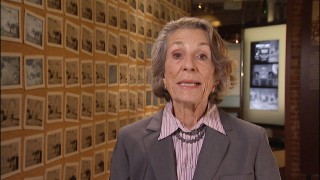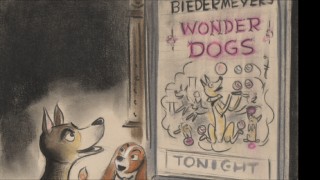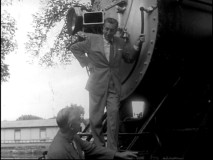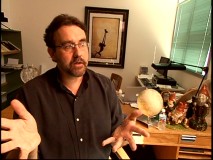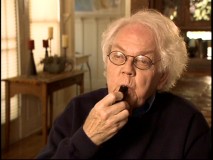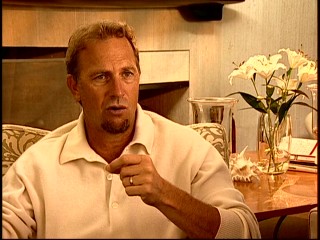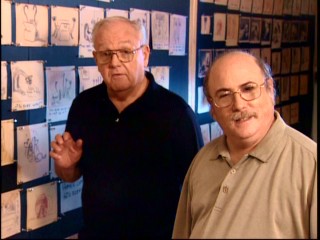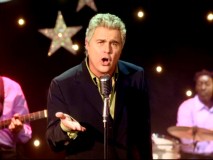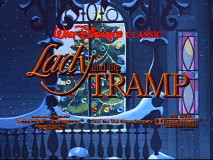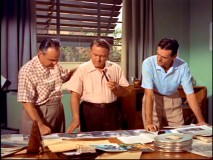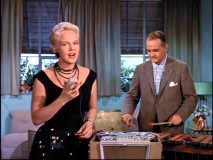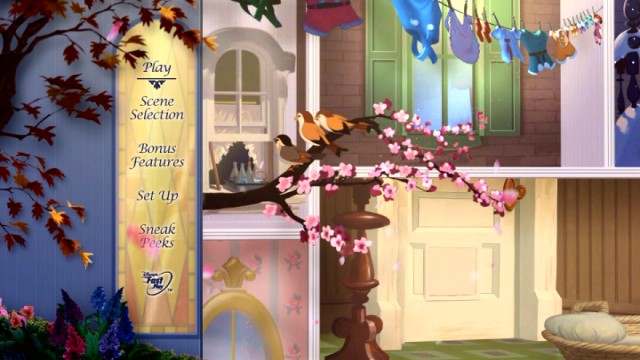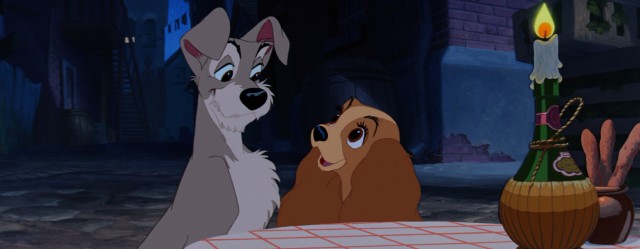Lady and the Tramp: Diamond Edition Blu-ray + DVD Review - Page 2
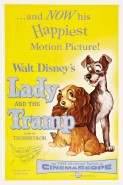 |
Lady and the Tramp
Theatrical Release: June 22, 1955 / Running Time: 76 Minutes / Rating: G Directors: Clyde Geronimi, Wilfred Jackson, Hamilton Luske / Writers: Ward Greene (the story); Erdman Penner, Joe Rinaldi, Ralph Wright, Don DaGradi (story); Joe Grant, Dick Huemer, Louis Pollock (uncredited) Voice Cast: Peggy Lee (Darling, Si, Am, Peg), Barbara Luddy (Lady), Larry Roberts (Tramp), Bill Thompson (Jock, Bulldog, Policeman, Dachshie, Joe), Bill Baucom (Trusty), Stan Freberg (Beaver), Verna Felton (Aunt Sarah), Alan Reed (Boris), George Givot (Tony), Dallas McKennon (Toughy, Pedro), Lee Millar (Jim Dear), The Mellomen - Bill Lee, Thurl Ravenscroft, Max Smith, Bob Stevens (Dog Chorus) Songs: "Bella Notte", "Peace on Earth", "What Is a Baby?", "La La Lu", "Siamese Cat Song", "He's a Tramp" |
Buy Lady and the Tramp from Amazon.com:
New: Blu-ray + DVD • Blu-ray + DVD + Digital Copy • BD + DVD in DVD Case
Previous: 2-Disc Platinum Edition DVD • Limited Issue DVD
BONUS FEATURES The Diamond Edition doesn't provide much in the way of new bonus features, but fortunately most of the many great DVD extras are retained. Choosing "Play Movie" brings up your first bonus feature options. You could just watch the movie or watch it preceded by an 81-second introduction from Diane Disney Miller. You can also watch it with Second Screen, the technology Disney has been touting that expands the viewing experience to an iPad or computer. The first screen, however (i.e. your TV), delivers "Inside Walt's Story Meetings", a feature first applied to Bambi which supplies dramatic recreation audio from real transcripts of Walt's meetings during the film's making. It's the closest thing we'll ever have to a Walt Disney commentary, but it's cooler than that since it gives us fly-on-the-wall access to real creative production discussions rather than the premature reflection and upbeat observations that most commentaries supply. It is amazing how many conversations pertaining to specific bits and gags are captured on record and tastefully brought to life here by actors. This is easily the highlight among the new additions and it can also be experienced as an ordinary audio commentary without the counter/subtitle-disabling Second Screen and its corner counter. There are three brand-new video supplements, each presented in HD. Under the Backstage Disney: Diamond Edition heading, we get "Diane Disney Miller: Remembering Dad" (7:57), which has Walt's daughter discussing the family's experiences in the apartment above Disneyland's firehouse, its Victorian decor full of cranberry red and mechanical things. It has nothing to do with Lady and the Tramp, but it's fascinating all the same and gives us a more personal side of Walt (down to how he liked his chili) than the reverence we usually get. The piece includes some stunning hi-def vintage park footage.
Next, come three all-new deleted scenes (19:11). They are presented via storyboard drawings with narrated stage directions. The long first bit has Russian pound dog Boris as a neighbor and potential love interest telling some tales about Hollywood and such. The brief second waits with Jim Dear for his baby's delivery. The third finds Lady and Tramp sneaking into a dog stage show and making a scene of the performance. These are not remotely worthy of making the movie, but they are fun to see here and now. Watch a clip of the deleted scene "Boris Meets Lady":
Music & More offers a tiny bit of the former and nothing else. It gives us the never-recorded Tramp song "I'm Free as a Breeze" (1:26) set to concept art and storyboards and performed by an uncredited. It's brief (just over a minute plus introductory screens), cheesy, and not at all compatible with the final character (it was written back in 1946). Aside from some standard listings -- Timon and Pumbaa's Blu-ray 3D pitch (4:23), standard digital copy how-to (1:04), and legal disclaimers billed lamely as "Info" -- the remaining extras fall under the header Classic DVD Bonus Features.
These begin with "Lady's Pedigree: The Making of Lady and the Tramp." You can watch this as one big 52-minute, 35-second documentary or break it down into seven distinct topical featurettes. The piece opens with "Return to Marceline", which considers the real Missouri small town where Walt grew up, an experience that supposedly influences Lady's setting. We hear from current residents, including some that somehow knew Walt. "A Perfect Little Lady: The Story of Lady and the Tramp" is one of the documentary's longest and most substantial sections. It tries to set the record straight and give Joe Grant the story credit he never received. His daughter, historians, and modern Disney animators discuss the project's origins and development while poking holes in the old Walt's Christmas hatbox present to his wife legend (though that is repeated in Diane Disney Miller's new movie intro). "Ruff Animation" is another long, meaty segment. It acknowledges the individual and collective efforts of Walt's trusted Nine Old Men. "Canine Chorus: The Music of Lady and the Tramp" obviously lives up to its title, focusing largely on the work of Peggy Lee (with comments from her daughter), but steering clear of her successful late '80s/early '90s multi-million dollar lawsuit against Disney for Lady royalties. "Teaching a Dog to Talk: The Voices of Lady and the Tramp" notes how the film relies heavily on accents and gathers some memories from what is now the only surviving cast member, Stan Freberg, who demonstrates how he delivered his lines as the Beaver with a whistle in his mouth. "Pretty as a Picture: Art and Design" talks about working in the CinemaScope ratio, considering the contributions of one particular background artist (Claude Coates) and the usual watercolor designs of Mary Blair. It also mentions simultaneously composing the film for the Academy Ratio, a fact that would seem to warrant an alternate presentation here. Finally, "Epilogue: Return Home" takes us back to Marceline for a brief wrap-up touching on the film's legacy.
"Finding Lady: The Art of the Storyboard" (13:02) has modern animator/director Eric Goldberg explaining the form and how it has gone from a unique Disney technique to being used in all modes of cinema. This broad survey considers storyboards use in cinema at large, from Alfred Hitchcock (with comments from his late production designer Robert Boyle) to Kevin Costner, with quite a bit of attention going to The Love Bug. "Original 1943 Storyboard Version of the Film" (11:52) has Goldberg and legendary Disney story man Burny Mattinson animatedly performing the parts (even the barking) of an early, quite different visual outline for the film. "'The Siamese Cat Song': Finding a Voice for the Cats" (1:52) isn't the politically correct apology you might expect, but some male outtakes set to concept art and storyboards of the lines that Peggy Lee would perform.
"PuppyPedia: Going to the Dogs" (9:22) has comedy actor Fred Willard at a dog park talking with owners about their pets. Their witty exchanges are complemented by information on seven different kinds of dogs (sporting, toy, etc.) which feature many Disney movie clips and a bit of real canine video. The "Bella Notte" music video (2:55) shows Steve Tyrell performing his 2006 standard take on the romantic song, with sets inspired by the film and some blurry VHS-quality film clips. Indeed, "Tyrell" rhymes with "swell." Three theatrical trailers are presented: a long one from the original 1955 release (3:48), a short 1972 reissue preview (0:41), and one emphasizing the Christmas angle for the December 1986 reissue (1:26). These are either shown in 1.33:1 or pillarboxed. Even if we are to believe that Disney wasn't thinking ahead shooting DVD extras in HD as recently as 2005 (something you'll find in great contrast to Walt's own ways), it seems like these trailers could and should have gotten an upgrade to HD.
Penultimate listing Excerpts from "Disneyland" TV Shows is one of the disc's highlights. It serves up an introduction (4:01), in which Goldberg explains the weekly anthology program's foresight to shoot in color and in the episodes' mixed quality here as patched together from the best available sources. An excerpt from "A Story of Dogs" (17:30, December 1, 1954) shows us the 1950s version of making-of promotion. Ed Penner shows off the film's story sketches, then there is some obviously staged and scripted direction occurring, leading into voice actor recordings and, no longer so excitingly, clips from the finished film. The "Cavalcade of Songs" excerpt (21:40, February 16, 1955) follows the film from inception to production, with more fake looks at the making including another storyboard pitch. Last but not quite least is the DVD's deleted scenes section (12:52), consisting of two scenes and two intros by Goldberg. The 3-minute "Turning the Tables" imagines a world where the roles of dogs and humans are reversed, while "The Arrival of Baby" gives us temp track of an earlier, extended version of "What Is a Baby?." Both discs open with trailers for Disney Studio All Access, Cinderella: Diamond Edition, Brave, and Beverly Hills Chihuahua 3 (actual on-screen exclamation: "George Lopez is Back"). The menu "Sneak Peeks" listings repeats those four, then plays ads for Disney Movie Rewards, ABC's "The Chew", "Shake It Up", Broadway's Mary Poppins musical, Lady and the Tramp II: Scamp's Adventure Special Edition, Disneynature's Chimpanzee, Secret of the Wings, and The Aristocats, Scamp and Aristocats to make their Blu-ray debuts. The DVD loses the "Chew", Poppins, and Aristocats promos. The combo pack's FastPlay-equipped DVD, evidently the only one this film will be getting for the time being, furthers the unfortunate trend of fans of that still handily most popular format getting just some scraps for bonus features. The only extras that make it to that disc are "Diane Disney Miller: Remembering Dad", the Fred Willard piece "PuppyPedia: Going to the Dogs", and Miller's film introduction. (It also includes the Blu-ray 3D and digital copy ads on a second page.) How insulting it is for Disney's crown jewels to get the kind of supplements slate it might have in the modest 2000 Gold Classic Collection, especially when there is such a wealth of pertinent material available on this film and loads of space to spare given its 76-minute runtime. You'd think they'd want to at least make the audio commentary available to a wide audience considering how much work was involved in producing that, but nope. Apparently, they really wanted to make this new DVD inferior to the movie's discontinued prior 2-disc set. WHAT'S MISSING? A number of bonus features from Lady's Platinum Edition DVD have not been ported over here, but most of those dropped are games and activities: the Disney Virtual Puppy DVD-ROM, the Disney Dog Trivia Virtual Board Game (which seemed to pave the way for the Disney dogs edition of the short-lived Disney DVD Game World series), a personality profile quiz. DVD and DVD-ROM games never did much for me, but the first two of those were unusually substantial and fun. More surprisingly and oddly lost is an art gallery. The Second Screen presumably supplies items to that effect, but those who geek out to animation concept art will be bummed not to have the DVD's 332 stills upgraded with Blu-ray's enhanced gallery technology. In addition, "Finding a Voice for the Cats" loses its introduction and, as a result, much of its meaning. Furthermore, the 1.33:1 "full screen" presentation of the film, seemingly nothing more than a cropping of the widescreen version, has been dropped, despite the film having been composed for Academy Ratio exhibition for theaters that couldn't show the film in CinemaScope. Any other casualties (like a Disc 2 Preview and dated ads for Chicken Little and the like) are understandable and self-explanatory.
MENUS, PACKAGING and DESIGN The two-disc set is available in both Blu-ray and DVD packaging; my review copy was the former. Its standard, side-snapped Blu-ray case is topped by an extensively embossed and largely holographic cardboard slipcover. Inside the case, the DVD (which, in a step-up from the bland grays they had been employing, colors Lady and Tramp against a silver back) is by default covered by three inserts. The best of these would be the Blu-ray Guide, a six-sided booklet that provides a chapters list, navigational overview, and some information on this set's most significant extras and the Diamond Collection line (next two releases: Cinderella in fall, Aladdin in spring). Another booklet provides a Disney Movie Rewards code and promotion. The final booklet of coupons and ads is filled with information on upcoming Blu-ray combo pack releases, including heretofore unknown 2 Movie Collections for the Pocahontas and Rescuers films. The Blu-ray disc loads with a clock graphic overstating the timepiece's importance in the film. The menu moves around a house with scenery shots and clips. The disc doesn't support bookmarks nor does it resume playback (why doesn't Disney offer these things as other studios do?!), but it does remember where you left off watching the film (and only that) if you didn't finish it in one sitting. The DVD's secondary menus play other songs or score excerpts while providing variations on the main screen.
CLOSING THOUGHTS Disney's latest Diamond Edition is another satisfying release of another great animated film. It's tough to imagine anyone strongly disliking the charming and fun canine caper Lady and the Tramp. The Blu-ray boasts another knockout feature presentation with loads of old extras and a few nice new ones. The set leaves nearly nothing to be desired, unless you're still a DVD-only household, in which it offers practically no value to you. Either way, you'll probably want to hang on to your Platinum Edition DVD, but those dropped games aren't likely to be revisited as much as the great content that has been ported over, the film most of all. Support great cinema and this site when you buy Lady and the Tramp now from Amazon.com:
|
Related Reviews:
<< Back to Page 1
DVDizzy.com | Disney Animated Classics | DVD & Blu-ray Reviews | Release Schedule | Disney Blu-ray | Upcoming Cover Art | Search
Disney's Diamond Edition Blu-ray + DVDs: The Lion King • Bambi • Beauty and the Beast • Snow White and the Seven Dwarfs
New to Blu-ray: Rebecca • Annie Hall • Real Steel | 1950s on Blu-ray: The Killing • Kiss Me, Deadly
Disney Dogs: 101 Dalmatians • Bolt • Beverly Hills Chihuahua • Disney DVD Game World: Disney Dogs Edition • Air Bud
Disney Animated Classic Blu-ray + DVD Combos:
Fantasia (2-Movie Collection) • Dumbo • Alice in Wonderland • The Fox and the Hound (2-Movie Collection) • Winnie the Pooh
Film and Video & Audio
